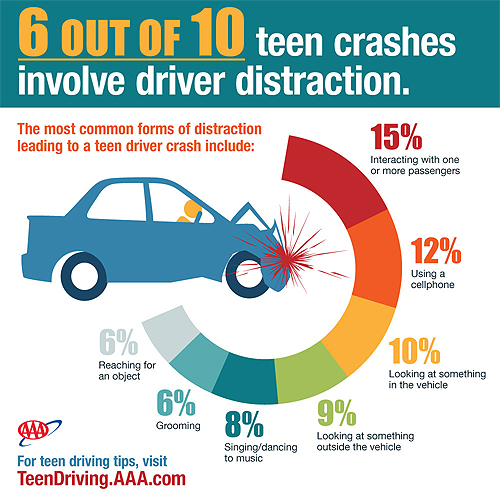
The AAA Foundation for Traffic Safety released the results from its most recent distracted driving study and the results are troubling. Quantifying the extent of the distracted driving problem has been difficult. There is no blood test for distracted driving and many folks just don’t admit they were distracted at the time of a crash.
This AAA study is what is called a “naturalistic” one, meaning that real drivers on real roads were studied through the use of cameras mounted in the cars. Other studies which have given us great information about distracted driving have been done in laboratories using driving simulators. Each type of study has its strengths and limitations, but this study specifically addressed the factors involved in teen crashes.
The teen participants were enrolled in a driver training program with Ltyx Drive Cam and had cameras and other instruments installed in their cars. When driving, if an event occurred that involved hard braking, swerving or the application of a certain amount of gravitational (g) force, a recording of the interior of the car, the driver, and the roadway, for 6 seconds before the event, with audio, would be preserved. This was the information that was collected and used for the study. All told 1,691 crashes were eligible for study. Here is a summary of what the researchers found:
- Driver inattention or being engaged in non-driving activity was involved in 58% of crashes
- 15% of the inattention crashes involved conversing or interacting with passengers (the bulk of those passengers were also teens)
- 12% of the inattention crashes involved driver cell phone use
- Teen drivers using cell phones looked away from the road an average of 4 of the last 6 seconds before the crash, and in 50% of rear impact crashes the driver exhibited no reaction at all before the crash
- Other distractions included looking at something inside the car, looking at something outside other than the road ahead, singing or moving to music, grooming and reaching for something.
Most traffic safety experts have been relying on NHTSA data (derived from police reports) which indicated that 14% of all crashes involved some type of driver distraction and of, those, about 7% involved driver cell phone use (which works out to about 1% of all crashes). The present study, limited to teens between the ages of 16-19, works out to cell phone usage being involved in about 7% of all crashes. NHTSA’s statistics were for drivers from all age groups.
Distracted driving for teens is more of an issue than we had thought, and cell phone use is just one of many distractions that are injuring and killing our children. Sates need to enact strong GDL (graduated driver’s licensing) laws limiting the number of teen passengers that can ride with a new driver and parents need to help enforce that. We need to continue to educatate on the dangers of cell phone use of course, but can’t limit our efforts to that.
From my perspective, my daughter is just as dead as if the driver had been using his cell phone (he was reaching for his GPS at the time he killed Casey).
Watch the videos from the study below which may be helpful for both teens and parents. (Our EndDD.org teen presentations have focused on many distractions and have not been limited to just cell phone use and texting.
https://youtu.be/SDWmwxQ_NnY
Click here to read the full study or a summary of the findings.






